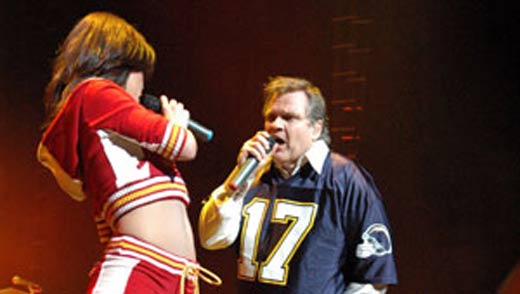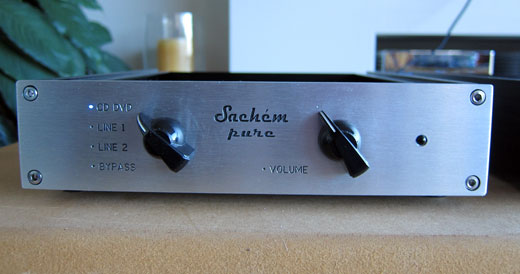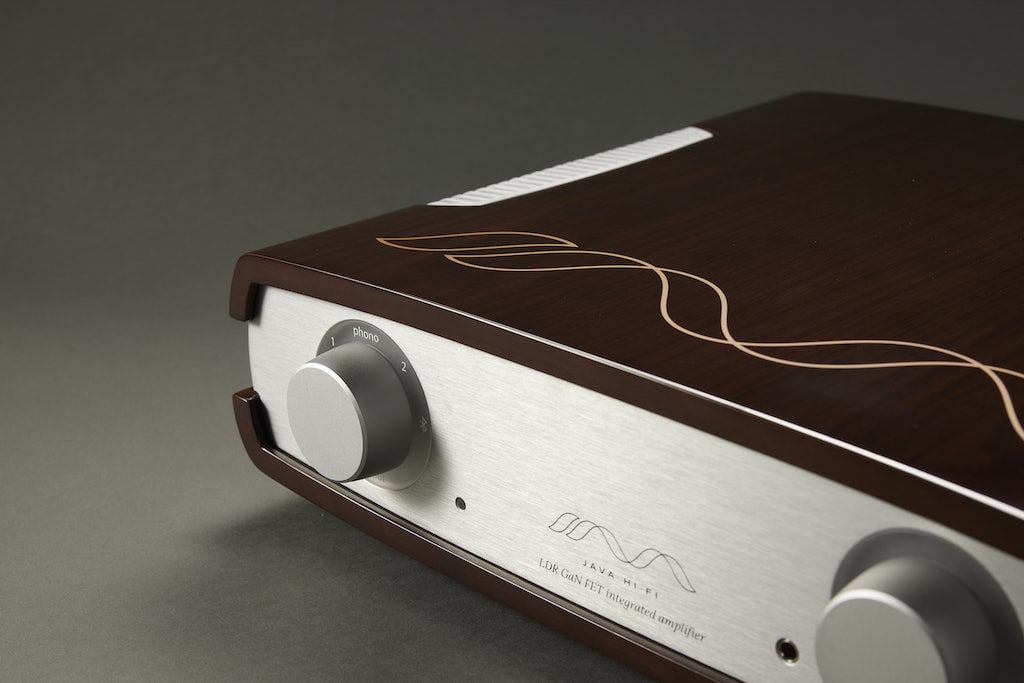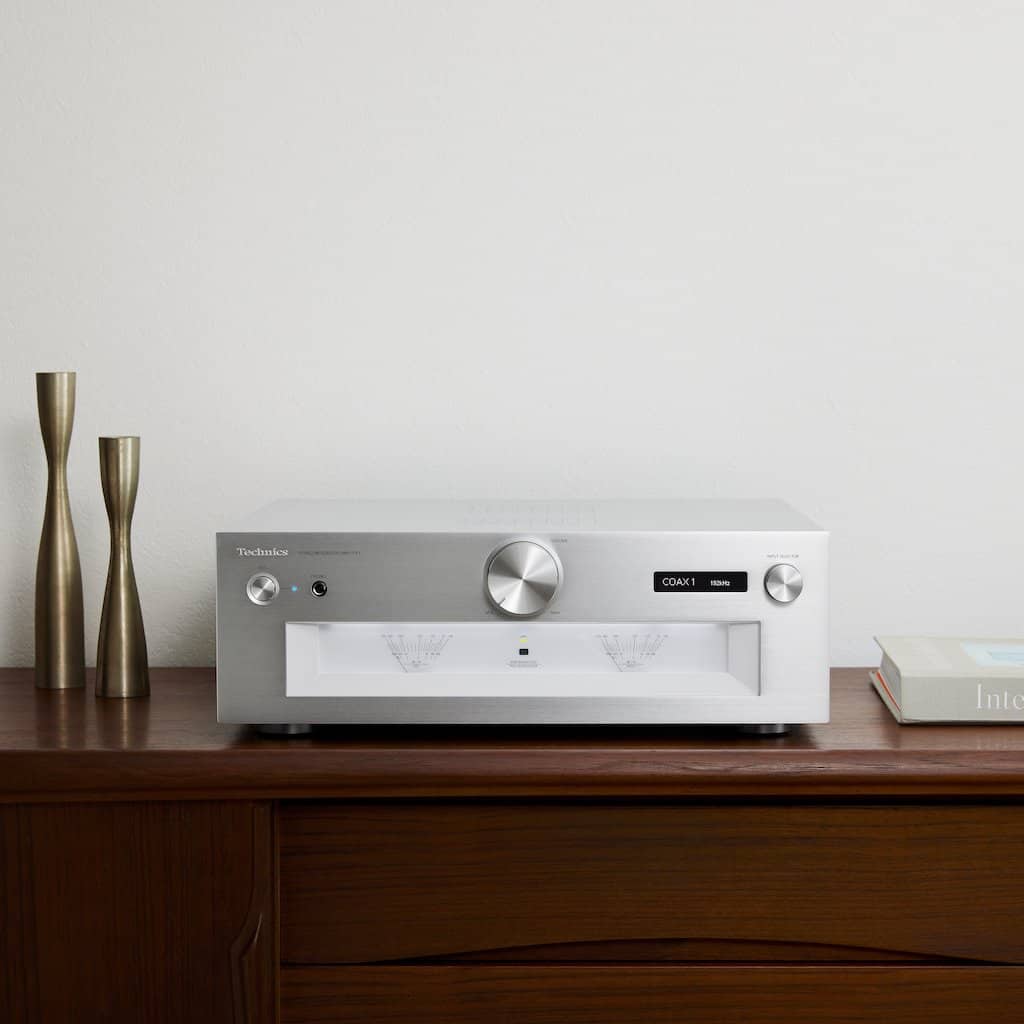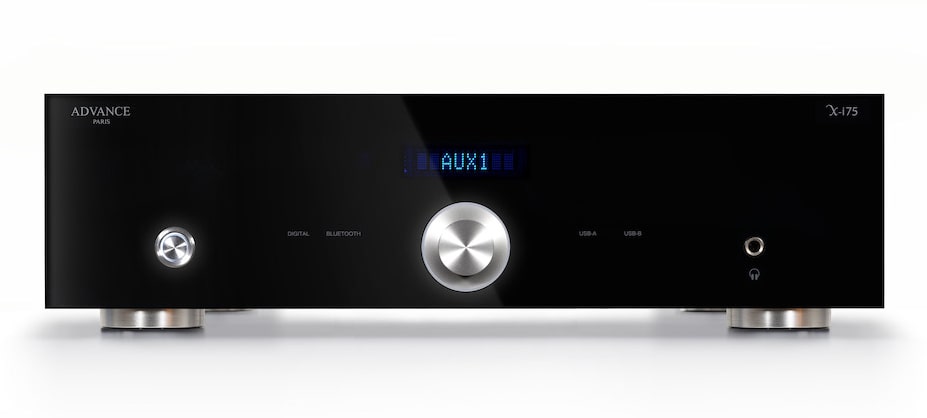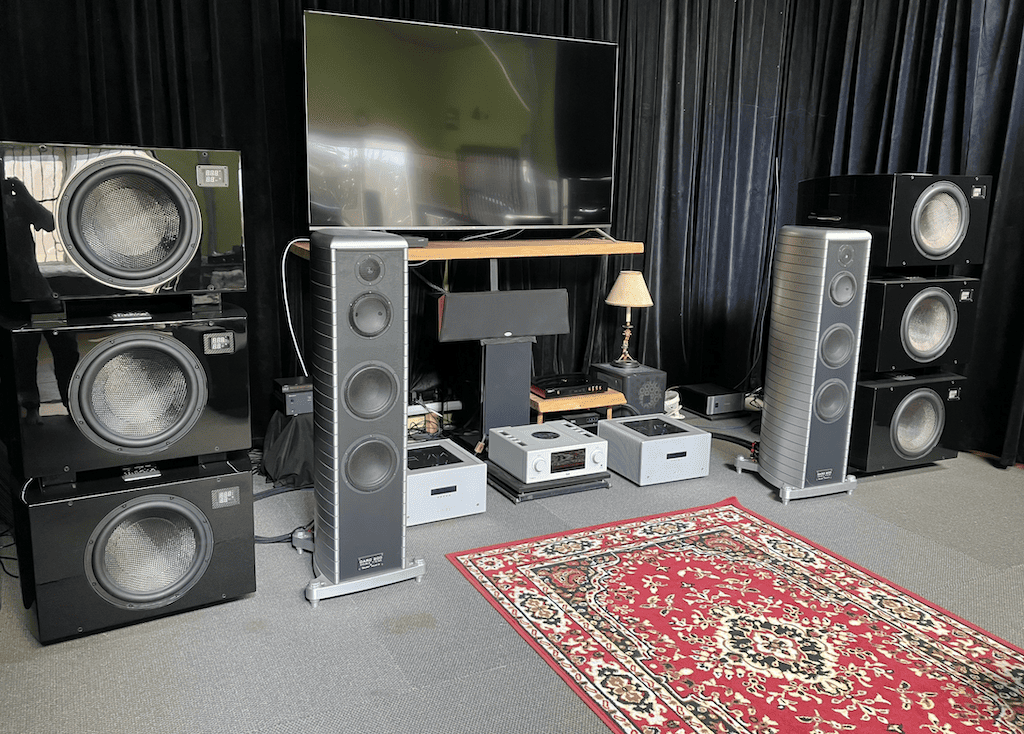$899
5 Stars
An amplifier-cum-DAC that not only acknowledges the 21st century, but brings a new meaning to the overworked term “cheap’n’cheerful”. Legend.
CALIFORNIA BASED COMPANY NuForce are best known for their high-end Reference series DACs, pre-amplifiers and Class D power amps. This makes for quite a contrast with their ultra-affordable audiophile-grade mini desktop DACs, amplifiers and headphone amps.
At about a hundred bucks shy of a grand, the Class D DDA-100 – with its 2-in-1 integration (amplification plus D-A conversion) – must surely be one of the audiophile bargains of the year. Sure, it doesn’t look like much – just a black box that does not accept any analogue inputs (so no turntables or analogue tuners) – but it’s the niftiest black box around.
What’s It All About?
Claimed to give around 75 watts into 4ohms or 50 watts per channel into 8ohms and with two pairs of quality speaker binding posts but no headphone jack, the DDA (Direct-Digital Amplifier)-100 should definitely be considered a true audiophile hi-fi amplifier, rather than just another desktop job. You can drive floorstanders with that much output, never mind your wee computer desk speakers at close range. Measuring 9-inches x 8.5-inches x 2-inches (d x w x h), the DDA-100 takes up very little room and could be placed virtually anywhere. It’s quite light – no massive transformers here – but sturdily built with high quality audio grade components.
 There are two TOSLINK inputs (and a TOSLINK output), one SPDIF Coaxial and one USB2.0 input. The SPDIF will accept sample rates of 16-24 bit/44.1 up to 176.4kHz, and the USB 16-24/44.1, 48 and 96kHz – so no support for 24/192 files and USB doesn’t support 88.2kHz.
There are two TOSLINK inputs (and a TOSLINK output), one SPDIF Coaxial and one USB2.0 input. The SPDIF will accept sample rates of 16-24 bit/44.1 up to 176.4kHz, and the USB 16-24/44.1, 48 and 96kHz – so no support for 24/192 files and USB doesn’t support 88.2kHz.
A 3GB over-sampling rate helps ensure smooth and natural sound reproduction while an on-chip clock reference signal “synchronises the incoming digital audio data… resulting in ultra-low jitter performance”. Along with the digital inputs, the power on/off switch is found on the back panel next to the IEC mains power socket. The inputs are selected by pressing the volume control repeatedly, while standby mode is operated by pressing the volume control once for on or holding it in for a few seconds for off. When turned on, the DDA-100 lights up attractively – and unobtrusively – with red LEDs, where the selected input and the volume level are displayed. Operation is very simple and nicely aided by the pocket-sized remote control. Another thing to note is the lack of a 3.5mm or USB input for mobile devices, such as iGadgets and Smart-droids; serious sources only need apply.
Now, there is something a little different about how the DDA-100 deals with a digital signal: it’s a DAC, but not in the traditional sense. Up until now one has quite rightly been led to believe that in order to turn a digital signal into an analogue signal – thus enabling it to be transported via your speakers to one’s ears – you need a digital to analogue converter (DAC) somewhere in the chain. Well, not necessarily…. apparently. Without a conventional DAC stage, the DDA-100 leaves this digital to analogue conversion to the last possible minute: at the speaker output stage. According to NuForce, this process, using PWM (Pulse Width Modulation) is where the “PWM power amplifier stage is modulated directly by the incoming signal and the digital-to-analogue conversion takes place at the speaker outputs. In effect, the PWM power amplifier stage operates as a power DAC”. Exactly how this works, I really don’t know and NuForce, perhaps understandably, aren’t particularly willing to share their secret. I got this from the horse’s mouth, via Tony Chandler of New Zealand importer International Dynamics:
 “About the DDA-100. The circuitry there is a proprietary design by one German chip maker but NuForce has been doing the R&D with them and we have put a lot of effort into it when optimising the implementation of this chip and fine tuning the sound. The whole product – when thinking sound-wise – is quite unordinary. The chip design has limits and thus the power is not huge. But the transparency and clarity is something beyond that price range. We can´t give too much information out from this technology. But I think the best way to tell would be like this (directly from the manufacturer): ‘The DDA-100 doesn’t require the typical DAC stage found in most of today’s digital audio products. Rather, its PWM power amplifier stage is modulated directly by the incoming signal, and the digital-to-analogue conversion takes place at the speaker outputs. In effect, the PWM power amplifier stage operates as a power DAC. This effectively eliminates the DAC-related problems that have plagued serious listeners in the past. Fewer parts result in a more direct signal path, resulting in benefits passed along to you: exquisite sound at an affordable price.’”
“About the DDA-100. The circuitry there is a proprietary design by one German chip maker but NuForce has been doing the R&D with them and we have put a lot of effort into it when optimising the implementation of this chip and fine tuning the sound. The whole product – when thinking sound-wise – is quite unordinary. The chip design has limits and thus the power is not huge. But the transparency and clarity is something beyond that price range. We can´t give too much information out from this technology. But I think the best way to tell would be like this (directly from the manufacturer): ‘The DDA-100 doesn’t require the typical DAC stage found in most of today’s digital audio products. Rather, its PWM power amplifier stage is modulated directly by the incoming signal, and the digital-to-analogue conversion takes place at the speaker outputs. In effect, the PWM power amplifier stage operates as a power DAC. This effectively eliminates the DAC-related problems that have plagued serious listeners in the past. Fewer parts result in a more direct signal path, resulting in benefits passed along to you: exquisite sound at an affordable price.’”
As you can see, I already told you much of that anyway. What I do know is that the DDA-100 is a model of simplicity: no digital to analogue conversion, no gain stage, almost a pure, straight signal path. That has to be good, right? Add to that, no balance or tone controls, and no unnecessary filter options, either.
More important than how it’s done (in my house, anyway) is how it sounds, and to find out I used a variety of speakers – the two pairs I currently own which are Spendor SP2/3s and Reference 3A Veenas, along with Paradigms’ excellent little Signature S1 V3 standmounts and a rather gorgeous pair of Q Acoustics Concept 20s, which I currently have in to review. Sources were my laptop running Windows 8.1, my Logitech Squeezebox Classic and an old Denon DVD-1930 DVD/SACD player, using Rule_Connect power cables and QED speaker and digital cables. I mostly streamed files of varying sample rates from my PC as well as online from streaming/radio site Jango, which generally has excellent sound quality and is great for discovering new and previously-unknown-to-me bands and artists.
The DDA-100 mated with my laptop almost instantly, no drivers required, and I was ready to go once I’d set things up in the computer’s sound control panel. I gave the amplifier a bit of time to run in (just in case this was necessary) and then it was a matter of selecting some music and settling back with a hot cuppa and a grin.
Sound Quality
To start with I fired up some tracks from Rickie Lee Jones’ gorgeous – her cover of David Bowie’s ‘Rebel, Rebel’ is exquisite – 1993 album Traffic From Paradise, and was immediately impressed with the smooth, natural flow of music, a surprisingly quiet noise floor and the clear, grain and fatigue free sound. Jones’ voice was starkly clear and delicate against that quiet background while the accompanying instruments sounded rich and detailed, with plenty of rhythmic urge where expected, and there was a reasonably wide and balanced dynamic range. Closing my eyes, it was hard to believe this was a fully digital amplifier/DAC. Nope, she doesn’t exactly sound analogue in the traditional sense, but that smoothness and lack of glare and harshness made for a most pleasant and addictive listening experience.
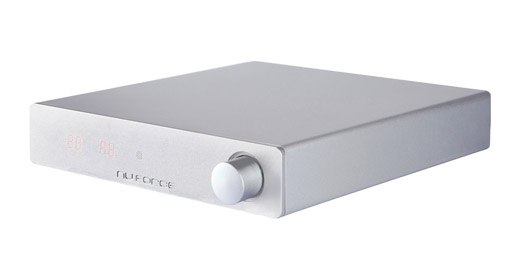 Songs from Greg Brown’s 2000 Covenant album were equally impressive with good pace and rhythm, and I was given an excellent insight into Brown’s husky and gritty vocal style as his voice was presented free and clear from the other performers. Bass was pretty good, even with the 88dB/8ohm Spendors, and drum strikes were delivered with a good sharp whack when appropriate. Perhaps it could be easy to dismiss or overlook a small, unassuming looking metal box, but 50 watts into 8 ohms is nothing to scoff at and, along with some decent detail retrieval, I got a roomful of sound (okay, I don’t have a large room in my house) with superb sound-staging and sonic projections (where some sounds within a performance seem to sit several feet in front of the speakers) and acceptable imaging. I could – and indeed tried to – listen for hours.
Songs from Greg Brown’s 2000 Covenant album were equally impressive with good pace and rhythm, and I was given an excellent insight into Brown’s husky and gritty vocal style as his voice was presented free and clear from the other performers. Bass was pretty good, even with the 88dB/8ohm Spendors, and drum strikes were delivered with a good sharp whack when appropriate. Perhaps it could be easy to dismiss or overlook a small, unassuming looking metal box, but 50 watts into 8 ohms is nothing to scoff at and, along with some decent detail retrieval, I got a roomful of sound (okay, I don’t have a large room in my house) with superb sound-staging and sonic projections (where some sounds within a performance seem to sit several feet in front of the speakers) and acceptable imaging. I could – and indeed tried to – listen for hours.
With 2004’s Conscious Roots compilation – featuring New Zealand roots and reggae artists like Katchafire, Che Fu, the Black Seeds and Trinity Roots – crisp cymbal strikes kept time with grooving bass lines and in such an “illuminated” way that it further demonstrated its rhythmic abilities. Instruments throughout the album displayed believable timbre and presence, with that dark, silent background helping to accentuate the illusion of space and air between the performers. Bass could have been deeper on Salmonella Dub’s contribution, ‘Problems’, but it had good energy and definition and didn’t overshadow the other sounds and effects. Imaging and image perception were as near to perfect as one could expect at this level, too.
When using the Reference3A speakers, I listened to the title track from The Cruel Sea’s seedy desert blues album This Is Not The Way Home (released in 1991), and found the DDA-100 couldn’t quite keep the weighty bass in check at higher volumes – though it did still have a nice level of warmth and energy – but still managed for the most part to procure a believable field of sound, albeit without the depth, muscle and openness a more substantial amplifier can provide. I may, of course, have been asking too much of the amplifier in this case. The acoustic guitar on ‘I Feel’, two tracks on, did sound a touch dry and lacked a bit of the sparkle which can bring an instrument to life, but was otherwise enjoyable. This is where, if I had to, I could fault the NuForce. I did think that a little bit of warmth or soul in the midrange and treble might have been nice, from time to time, as I detected hints of a clinical nature with the various speakers to varying degrees. But overall the sound was extremely good.
The little DDA-100 tended to be generally quite forgiving in nature, gently smoothing over some of the harder or harsher edges present in some recordings, but without taking away the main character or drive of the music. Where my Unison Research amplifier (a beast by comparison) can often be rather unforgiving with less than perfect source material – or source components for that matter – the NuForce was more likely to take everything in its stride, giving a truly remarkable musical presentation with little to count against it for the price.
Unsurprisingly, of the speaker combinations I tried, it was the easy to drive Paradigms which performed the best, though the NuForce gave the others a good crack. Match your speakers carefully and I warrant you’ll be happy for years to come provided, dare I say it, you don’t intend to get into vinyl somewhere along the way.
Conclusion
I hope it doesn’t appear condescending to keep using the term “for the price”, but it really is unavoidable. It isn’t perfect, but for the money the NuForce DDA-100 is a very tempting proposition. I’m not about to suggest it’s in giant killer territory, but you certainly get a commendably high level of performance for such a small price (there I go again). I hate to say this but some audio manufacturers may well have a reason to get their respective thinking caps on, because this brings the term “cheap ‘n’ cheerful” to a whole new level.
If you already have a decent amplifier and are wanting to dip your toes – or your wallet – into this new age of digital, computer based music, then for the same money, I might suggest you consider the excellent Rotel RDD-06 DAC. But if you’re starting out, upgrading, side-grading, setting up a second system or you just bloody want one, I reckon you can’t go wrong with the DDA-100. Just remember the slight sample rate limitations, though it didn’t bother me particularly.
For 900 bucks, you get a great amplifier with decent built-in digital to analogue conversion and, if the Paradigms are anything to go by, you can get away with considerably more expensive speakers – relatively speaking – for a very simple, unobtrusive and high performing hi-fi system for the pure enjoyment of listening to music. To award the DDA-100 anything less than 5 stars would just be mean. ANDREW BAKER



